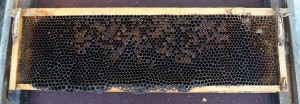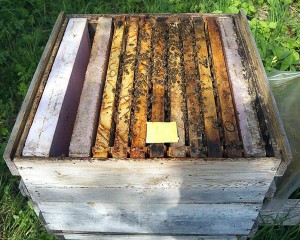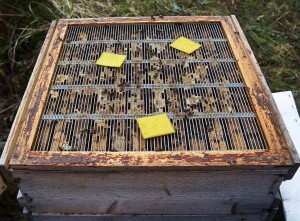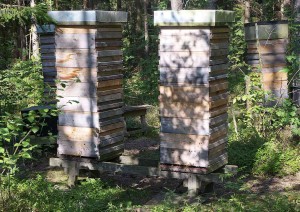Yes, do struggle for resistant bees. Don’t just talk about it! Or say an easy no, it’s impossible, or an easy yes: ”Just do like I tell you.” Tell me your success story. I tell you mine, well a part of it here.
1989 I went to Kenya and got breeding material from Apis mellifera monticola, the mountain bee. Yes, that was a good longshot. I don’t regret it. In 2000 I visted Lusby’s in Arizona and got hooked on smaller more natural cellsize. I don’t regret that either, even if I’m not sure how much it helps against varroa mites. It’s more natural and bees don’t perform worse with it, in any way. Natural selection benefits survival and it has selected for small cell size in brood area at least. There are obvious benefits like rapid spring build up.
I thought I had regressed my bees down to 4.9 mm cell size when varroa hit hard in 2008. The mites arrived a couple of years before to my area. But it turned out when I analyzed the dead colonies following that many had too many badly drawn combs.
 Quite some combs looked like this, but they are gone now.
Quite some combs looked like this, but they are gone now.
My plan A was that I wouldn’t need any treatment against the mite as I had African genetics in my bees and they were small cell. But a gut feeling told me to have a plan B if something should go terribly wrong. And it did
I didn’t want to use acids as my conclusion was, wrong or correct, that formic is to hard at the bees and dangerous for me. Oxalic put me also in danger as I can’t smell oxalic fumes, but formic it’s no problem smelling. Inner organs and skin you know. I want to keep them going. Nerve poisons like Fluvalinate and organic phosphates like Coumaphos, cancerogenic like Amitraz and it’s breakdowns. My gut said no. The only thing left was Thymol. Yes it kills a lot of microbes as well. But it’s a spice and you find somewhat in basswood honey.
My conclusion was that it’s better with some living colonies than all dead. You can select the best among the living. It’s no use among the dead. Was it possible to use less and less Thymol? The bees were so overhelmed with DWV (Deformed Wing Virus) and mites that no one would have been left of my 250 colonies in 2008. Well, maybe 10 % when autumn 2009 came,…. When spring came 2009 I had lost 50 %. I got a feeling the mites were filled with viruses when coming to the area. I lost several tens of thousands of dollars in left out income in struggle for more resistant bees. But I didn’t want to get caught in the chemical trap.
Thymol for susceptible bees you need minimum two trays with 25 g thymol each (50 g in total). 10-14 days apart. If only treatment normally too little in a year. For some years now 80 % of my bee colonies have been treated. I have used in average10-15 g of thymol a year on my colonies (all included then). A few needed 35-40 g. They have of coursed got new queens.
 One piece of Thymol with 4-5 grams on a struggling colony in spring.
One piece of Thymol with 4-5 grams on a struggling colony in spring.
I now winter about 170 colonies. I have lost 15 % of the colonies the last winters. (But this winter seems to end much better.) 30 % of those that survive have been small, got treated and new queens and gave no honey. The average honeycrop, including the 15 and 30 % mentioned has been about 50 pounds (25 kg). The top colony almost every year reach 400 pounds. The apiaries differ a lot in yielding nectar.
 15 g of Thymol on a strong colony in summer, with supers above the excluder. Few cases.
15 g of Thymol on a strong colony in summer, with supers above the excluder. Few cases.
I treat only (and I do it mostly right away regardless when it is in the season) when I see a couple of deformed winged bees outside or inside the hive. The hives are equipped with a board half a meter in square in front of the entrance for easier seeing what the bees are dragging out of the hive. Mostly the colonies are being treated in spring or in late summer. Those few treated with honey supers on get the honey ventilated in zig-zag stacks of supers in a warm room with a fan going for at least a week before extracting. To vent out thymol smell.
There’s only my stock of bees in quite a big central area where I have my bees. In the outer areas my bees dominate. I keep about 10 colonies in each apiary and they are as close as I can find places for them. 1 mile (1.5 km) between them would be ideal. The queens are mated in the apiaries.
Last year (2013) I used thymol on 50 % of my bees. In average I used 5 g thymol, all colonies included. For breeders I use colonies that havn’t been treated for at least the two previous years. The number of breeder candidates has increased for every year. Last year I started to check the VSH trait. I think this will make it possible to check eventual breeders a year earlier then before.
The VSH tests I did last year on my 5 breeders gave the following results: 1) 50 %, 2) 40 %, 3) not possible as I didn’t find one single mite in the brood, 4) not possible as the four year old queen died of age early (I just was able to make one graft), 5) not possible as the three year old queen produced more than 50 % drone brood.
 A good apiary. Bee escapes on. Next visit the bee blower rids the boxes from the remaining bees. It will be when yo take 4 boxes like from the colony to the right. (That’s at least 150 pounds of honey).
A good apiary. Bee escapes on. Next visit the bee blower rids the boxes from the remaining bees. It will be when yo take 4 boxes like from the colony to the right. (That’s at least 150 pounds of honey).

Eric- Do your production colonies get any brood breaks during the season or do they go straight through winter to winter with the existing (or supercedure) queens? Do you make many splits or keep nucs for replacement queens?
Hi Richard
Yes, all colonies do get one major brood break in winter time. How long it is depends on type of bees. Italians can brood well into October and start in the middle of the winter in January depending on temperature. My bees, with old queens, stop already normally in middle of August. From middle of October, normally, they don’t fly out of the hive, at least from November, normally. When light increases, I’m on 59 degree latitude (15 degree longitude), they are sensitive for the temperature. They start brooding in January again, even if it’s well below freezing, in small amounts at least. In beginning of March, still confined too the hive without a cleansing flight, they increase brood considerably. They know time is coming. In late March normally is the time for the main cleansing flight. Ten degrees Celsius (50 F). Then brooding explodes, unless a really cold period starts.
A brood break is of course beneficial for resistance to Varroa, but not crucial. Many things are beneficial for Varroa resistance, but not crucial on its own. Most important trait are bees chasing mites, in brood in first place (especially mites with progeny), VSH-trait.
So if you have no brood break, bees should be able to handle that too. But few places are without brood brakes altogether, droughts for example should result in much less brood or no brood.
I make splits to replace the the dead outs, about 30. I take a square shallow brood box (12 frames with bees, brood and food) without the queen and move it to another apiary where they make a new queen by themselves. About 50 colonies and those splits that fail to make a queen get a mature queen pupa that is bred from a breeder colony. I keep no replacement nucs. Some extra splits are my replacement “nucs”.
I want the colonies to keep as much food as possible for winter, at least 60 pounds. I’m happy if it’s all honey.They don’t need that much during winter, but in spring when brooding get going strongly.
Erik- I was just trying to get an idea about whether brood breaks are a large part of your management in regards to staying treatment free as much as possible. I do feel like the most important traits are those that the bees use to eliminate or control varroa. Since I have been in expansion mode for the last 5 years, I do a lot of splitting, and keep about 40 to 50% of my colonies as nucs, so there are plenty of brood breaks with the nucleus colonies especially. This I’m sure has some impact on my ability to remain treatment free. I am increasing the percentage of production colonies that I keep, so it is becoming more important that my bees deal with varroa without the extra brood breaks that I have been creating.
I am in the mountains of VA, US at 682 m above sea level, 37 degree lattitude. Our bees usually winter on about 45 lbs of honey.
Thanks for your insight.
Yes, Richard, of course when you do so many splits and get brood breaks it makes the fight against the mites easier.
But being treatment free for 5 years had not been possible without some other help as well.
Quite isolated from other bees do help a lot. But even in such a situation your bees have to have some good basic mite fighting trait (and good management) to be able to thrive without treatment.
You don’t open the colonies every second day and look for the queen for example. That would disturb their normal activities.
I guess you use some good stock of bees as well.
Some day it would be normal to experience some colonies loosing the fight against the mites. Then split them as soon as possible and give the splits soon hatching queen cells. Anyway I would do that.
It would surprise me if you would experience an accelerating number of hives crashing.
When I started expanding I used local swarms, cutouts, VSH, and Russian bees. Spring of 2012 I had 25 different sources of queens in my yards. Last winter (’12-’13) I lost 40% of my colonies to what I believe was varroa/virus load. Other years my losses were in the 10-15% range. The survivors from last year looked very good. I split back to my original numbers using my own queens and VSH virgins mated in my yards. We had a good year of forage last summer and they went into winter healthier looking than ever. Losses have been very low this winter in spite of colder than normal weather.
So it seems last winter was the the collapse time for my bees. The question is – how often will this occur? Will it depend mostly on the infiltration of poor genetics? Or will things balance out if I rear my own queens?
That was a good mixture of bees you started with. You probably had your big collapse last winter. I think your are in control of the situation. If you don’t have too much infiltration of bees from “outside” and you concentrate on rearing your queens from your best mitefighters it would surprise me if you will experience more high winterlosses.